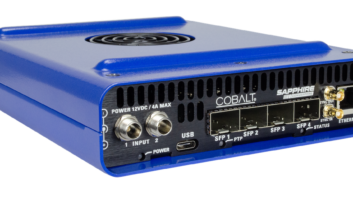Codex Digital is launching a new, high-resolution portable field recorder which the company boldly claims has the potential to revolutionise digital cinematography and the production of motion pictures and high-end TV.
No larger than a toaster, the Codex Portable’s cutting-edge design is packed with features and technology – creating brand new opportunities for single and multi-camera production. The Codex Portable can record from virtually every digital camera from HD to 4K. It is quick to deploy – on set, at a sports event or up a mountain – and the company claims it can take production workflow to unprecedented levels.
The new system has been designed to meet industry demand for a compact and rugged field recorder. It complements the original, award-winning Codex HD, 2K, 4K media recorder/server, which is being used on major studio productions in the US and Europe. Using visually-lossless compression, the Codex Portable brings cinema-quality disk-recording to every production where uncompressed recording is not an absolute demand, but total portability is.
Constructed from carbon fibre and with rubber-sealed connections, the Codex Portable is tough, weather-resistant, and weighs only 4Kg. It is powered from standard camera batteries, and can be carried on an operator’s shoulder or back, or secured on camera equipment such as dollies and cranes.
Taking its key features from its larger sibling, the Codex Portable adds immediate full-frame playback and review of footage on a daylight-readable touchscreen. Also unique is its secure wireless system, which enables instant shot monitoring, or remote-control of the system, from any networked computer or PDA. The Codex Portable even features a special “Mutter Track” microphone input, which allows the user to add comments during a take for shot-logging and notes.
Top-line features include two dual-link HD 4:4:4 inputs, Infiniband and Ethernet data-connections, 10Gbps optical I/O, timecode and control ports, eight channels of audio, HD and SD monitoring of all formats up to 4K, and MP4 wireless video output. Flexible I/O configurations mean the Codex Portable can record from virtually every digital camera available today – including all HD cameras in video mode, plus data-mode from cameras such as the ARRI D-20 and DALSA’s Origin. It can also record Red Digital Cinema’s RED ONE camera in 4K data-mode, when it becomes available.
Recording is made to hot-swappable, shock-mounted RAID diskpacks that can hold up to three hours of continuous recording at the system’s highest quality – the first portable recorder (disk or tape) to offer such capability and capacity. The compression method used is JPEG2000, a wavelet-based industry standard, which is visually indistinguishable from the original and is comparable to the highest-quality mode of HDCAM-SR tape.
It also has the unique ability to record from two 4:4:4 cameras simultaneously – either independently for A and B cameras, or locked together for 3D stereoscopic acquisition. It is also the first to record from four 4:2:2 cameras simultaneously, and to allow the complete synchronisation of multiple recorders. With this feature, six synchronised Codex Portables can act as a 24-track video, 48-track audio-recorder – enough to record an entire concert or sports event at cinema-quality in a package no larger than a couple of tape decks.
After recording, the Codex Portable’s diskpacks may be plugged directly into the matching Codex Transfer Station. This copies them (much faster than realtime), backs them up, and then delivers the material, plus the associated metadata, across local or worldwide networks. In conjunction with the Transfer Station, the Codex Portable can deliver shots in all industry-standard formats, including DPX, BMP, BWAV, QuickTime, AVI and MXF files. It can even provide native-mode files that editing-systems can use with no importing at all.
“We have developed our new portable with a no-holds-barred approach,” said Paul Bamborough, a co-founder of Codex Digital. “There are huge advantages in shooting direct to disk, and we are making those available to all productions – cinema or TV – who want the highest quality but who also need complete portability.”
Codex Digital expects to ship production Codex Portable systems in late 2007.







